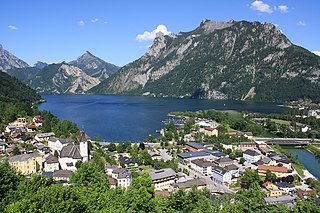 W
WThis is a list of subcamps of the Mauthausen concentration camp. The slave labour of the inmates was also used by a variety of companies and farms that accommodated a small number of inmates on their own.
 W
WMauthausen was a Nazi concentration camp on a hill above the market town of Mauthausen, Upper Austria. It was the main camp of a group with nearly 100 further subcamps located throughout Austria and southern Germany. The three Gusen concentration camps in and around the village of St Georgen/Gusen, just a few kilometres from Mauthausen, held a significant proportion of prisoners within the camp complex, at times exceeding the number of prisoners at the Mauthausen main camp.
 W
WEbensee is a market town in the Traunviertel region of the Austrian state of Upper Austria, located within the Salzkammergut Mountains at the southern end of the Traunsee. The regional capital Linz lies approximately 90 km (56 mi) to the north, nearest towns are Gmunden and Bad Ischl. The municipality also comprises the Katastralgemeinden of Langwies, Oberlangbath, Rindbach, Kohlstatt and Roith.
 W
WGranitwerke Mauthausen was one of the names used by the DEST company for its branch based in Sankt Georgen an der Gusen and which exploited the slave manpower confined in certain subcamps of the Mauthausen-Gusen concentration camp system: Gusen I, Gusen II, Gusen III, and Mauthausen.
 W
WThe Hartheim Euthanasia Centre was a killing facility involved in the Nazi programme known as Action T4, in which German citizens deemed mentally or physically unfit were systematically killed with poison gas. This was initially a programme of involuntary euthanasia permitted under the law ostensibly to enable the lawful and painless killing of incurably ill patients; these killings continued even after the law was rescinded in 1942 and extended to include Jews, Communists and others considered undesirable by the state. Concentration camp inmates who were unfit for work, or otherwise deemed troublesome, were also executed here. The killing centre was housed in Hartheim Castle in the municipality of Alkoven, near Linz, Austria.
 W
WK.L. Reich is a semi-autobiographical novel written by the Catalan author Joaquim Amat-Piniella. It is based on his experiences as a Spanish Republican prisoner in the Mauthausen concentration camp during the Second World War. The first version was written in Andorra between 1945 and 1946, following Amat-Piniella's liberation from the camp. However, its publication was delayed for 17 years by state censorship in Franco's Spain. It was finally published in 1963, first in Spanish translation and then in the original Catalan.
 W
WThe Messerschmitt Bf 109 is a German World War II fighter aircraft that was, along with the Focke-Wulf Fw 190, the backbone of the Luftwaffe's fighter force. The Bf 109 first saw operational service in 1937 during the Spanish Civil War and was still in service at the dawn of the jet age at the end of World War II in 1945. It was one of the most advanced fighters when it first appeared, with an all-metal monocoque construction, a closed canopy, and retractable landing gear. It was powered by a liquid-cooled, inverted-V12 aero engine. It was called the Me 109 by Allied aircrew and some German aces, even though this was not the official German designation.
 W
WThe Messerschmitt Me 262, nicknamed Schwalbe in fighter versions, or Sturmvogel in fighter-bomber versions, was the world's first operational jet-powered fighter aircraft. Design work started before World War II began, but problems with engines, metallurgy and top-level interference kept the aircraft from operational status with the Luftwaffe until mid-1944. The Me 262 was faster and more heavily armed than any Allied fighter, including the British jet-powered Gloster Meteor. One of the most advanced aviation designs in operational use during World War II, the Me 262's roles included light bomber, reconnaissance and experimental night fighter versions.
 W
WThe Mühlviertler Hasenjagd was a war crime in which 500 Soviet officers, who had revolted and escaped from the Mühlviertel subcamp of Mauthausen-Gusen concentration camp on 2 February 1945, were hunted down. Local civilians, soldiers and local Nazi organizations hunted down the escapees for three weeks, executing most of them. Of the original 500 prisoners who took part in the escape attempt, eleven succeeded in remaining free until the end of the war. The mass escape was unique in Mauthausen's history.
 W
WArnold E. Samuelson (1917-2002) was a combat photographer during World War II who was among the first Allied photographers to document Nazi war crimes.
 W
WSankt Georgen an der Gusen is a small market town in Upper Austria, Austria, between the municipalities of Luftenberg and Langenstein. As of 2015, the town had 3,779 inhabitants.
 W
WWiener Neudorf is an Austrian town in the eastern part of the Mödling district, south of Vösendorf and Maria Enzersdorf, west of Biedermannsdorf, and north of Guntramsdorf.
 W
W W
W W
W W
W W
W W
W W
W